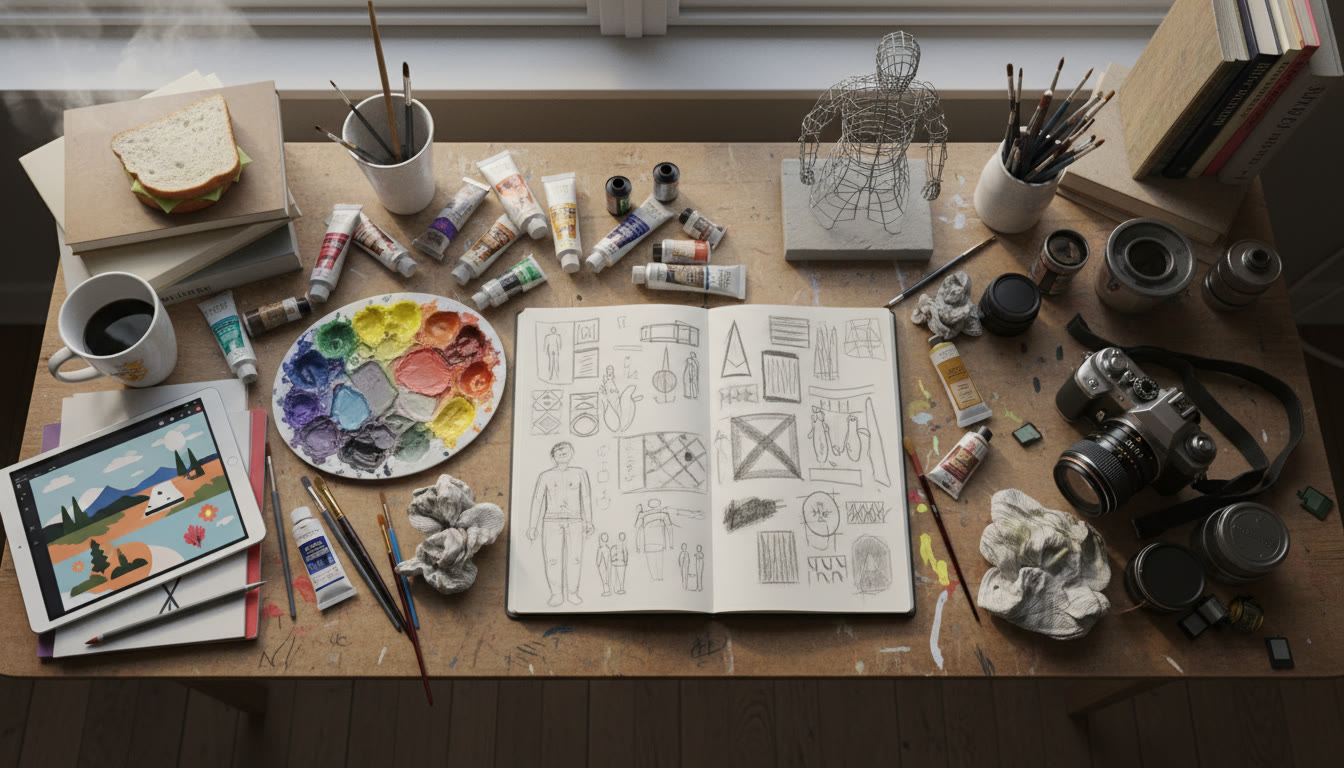Why AP Art Matters in College Applications
For many students, AP Art (whether 2-D Design, 3-D Design, or Drawing) is more than a class—it’s a body of evidence that shows how you think, experiment, and commit. Admissions officers aren’t just looking for polished pieces; they’re listening for a narrative. AP work, when presented thoughtfully, becomes a ticket to tell a convincing story about your creative identity, discipline, and potential as a college student.

AP Art as Academic Credit and Creative Proof
Beyond the promise of potential college credit, AP Art signals several things to an admissions reader: technical skill developed over time, the ability to follow through on long-term projects, and familiarity with critique and revision. These are academic strengths in a different language—visual rather than textual—but no less persuasive.
Crafting a Portfolio That Tells a Cohesive Story
A portfolio is not a catalog. Think of it as a curated exhibition with a beginning, middle, and end. Your AP portfolio should lead a viewer through your interests, show how you wrestled with problems, and end with a confident statement of who you are as an artist.
Start with a Concept
Successful portfolios usually begin with an idea. This could be a recurring theme (identity, memory, environment), a formal exploration (color relationships, negative space, texture), or a technical journey (shifting from representational drawing to abstraction). Decide what connects your pieces and let that guiding idea help you select work.
Selecting Pieces: Quality Over Quantity
- Choose pieces that reinforce your concept rather than every good artwork you’ve made.
- Include process work to show development: sketches, studies, failed experiments that taught you something.
- Aim for variety in media and approach if it still supports your narrative—this demonstrates curiosity and technical range.
Writing the Artist Statement: Say What Your Work Means
The artist statement is the voice that walks the admissions reader through your visual thinking. It should be concise, reflective, and specific—avoid vague pronouncements like “I love art.” Instead, explain choices, influences, and the reasoning behind your process.
Structure of a Strong Statement
- Begin with a one-sentence thesis: the idea that ties your work together.
- Follow with 2–3 short paragraphs that unpack how you approach materials, solve problems, and what you learned.
- End with a forward-looking sentence about where you want this work to go in college.
Using Your AP Coursework to Bolster Your Application
AP classes are a signal of academic ambition. When paired with a compelling art portfolio, they show that you’re serious about the craft and its intellectual demands. Here are practical ways to highlight AP Art in your application package.
Where to Feature AP Work
- Secondary School Report and Courses Section: Clearly list AP Art and any related electives.
- Common App or Supplement Essays: If an AP project shaped your perspective, use it as an anecdote in your writing.
- Portfolio Submissions: Upload selected AP works to college visual portals, ensuring images are high-quality and labeled with medium, dimension, and date.
Technical Presentation: Photographs, Scans, and Layouts
Admissions reviewers rarely see the original; your images must stand in for the real object. Technical care equals respect for your work.
Best Practices for Digitizing Artwork
- Use even, natural lighting. Avoid glare for glossy surfaces.
- Shoot at high resolution and crop to show the entire piece without cutting edges.
- For sculpture or 3-D pieces, include multiple angles and a scale reference (a ruler or hand).
- Name files consistently: “LastName_FirstName_Title_Medium_Year.jpg” makes life easier for reviewers.
Portfolio Checklist: What to Include
| Item | Why It Matters | Tip |
|---|---|---|
| Final Pieces (6–12) | Shows peak accomplishment | Choose for cohesion and range |
| Process Work | Shows thinking and evolution | Include annotated sketches |
| Artist Statement | Gives narrative context | Keep to 200–300 words |
| Technical Notes | Clarifies media and dimensions | Be precise and concise |
| Course List and Awards | Confirms commitment and recognition | Mention AP Art and Art-related awards |
How to Use AP Scores and the AP Studio Process
Where available, an AP score complements the portfolio by validating the assessment your work received. But remember: many arts programs prioritize the visual portfolio and recommendations over the numeric AP score. Be strategic—use the score to reinforce seriousness, not as a substitute for a compelling body of work.
Telling a Personal Story Through Art
Great portfolios reveal more than technique—they reveal a person. Whether your work is intimate and small-scale or bold and public, tie it back to a human experience: family, community, challenge, joy, or curiosity. Admissions teams remember specificity.
Example Narratives
- A student who explored family migration through portraiture and archival collage—works show research, empathy, and mixed-media skill.
- A sculptor who chronicled maker-space rebuilding after a local flood—projects document problem-solving, community engagement, and material innovation.
- An AP drawing student who evolved from photorealism to abstraction while maintaining a focus on urban light—work shows intellectual risk-taking.
Letters of Recommendation and AP Art Teachers
Your AP Art teacher is uniquely positioned to speak about your process, critique response, and growth. Ask for a recommendation that highlights project management, creative risk, and collaboration—qualities arts programs value highly.
How to Talk About AP Work in Interviews and Essays
When you’re asked about art in interviews or supplemental essays, don’t rehearse a generic summary. Use a specific project as an anchor: what problem you set out to solve, how you iterated, what failed, what succeeded, and what you learned. These small stories are memorable.
Story Skeleton to Use
- Situation: The prompt or problem (one sentence)
- Action: What you tried and why (two sentences)
- Result: What changed or what you discovered (two sentences)
- Next Step: How this informs your future artistic path (one sentence)
Balancing AP Rigor with Extracurricular Art
Colleges like depth and consistency. If you took AP Art as part of a larger, sustained practice—student clubs, independent commissions, community projects—make that clear. AP class provides structure; extracurriculars provide breadth. Together they form a richer picture.
Timeline: When to Build, Revise, and Submit
Start early. Building a compelling AP portfolio is iterative. Here’s a conservative timeline you can adapt:
- Junior Year Fall: Begin selecting work; photograph early pieces.
- Junior Year Winter: Draft an artist statement and seek critique from teachers.
- Spring to Summer: Revise pieces, create any missing works, and finalize digital files.
- Sophomore/Junior Summer: Use the time for concentrated production and trials; many students make breakthrough pieces when freed from daily school tasks.
Common Mistakes and How to Avoid Them
- Overloading the portfolio with technically perfect but thematically disconnected pieces—curate ruthlessly.
- Skipping process documentation—explain how things evolved.
- Low-quality photos—poor images can mask excellent ideas.
- Submitting a one-size-fits-all portfolio—tailor your selection or statement subtly if a college requests a discipline-specific submission.
How Personalized Support Can Make a Difference
Polishing a portfolio and tightening your artist statement benefits greatly from outside perspective. Personalized tutoring—1-on-1 guidance that focuses on your strengths and areas for growth—can speed up the revision loop. Expert tutors help you pick which pieces to keep, suggest photographic improvements, and coach you on how to talk about your work in essays and interviews. AI-driven insights can flag gaps or redundancies in your presentation, but real human feedback makes nuanced artistic decisions.
For example, Sparkl’s personalized tutoring matches students with tutors who understand both AP Studio expectations and college admissions. That mix—art critique plus application strategy—helps students translate a class portfolio into an admissions asset without losing the authenticity of their work.
Real-World Context: What Admissions Teams Look For
While techniques and innovation matter, admissions teams ultimately look for promise: evidence that you’ll contribute to campus life and grow in their program. That promise is shown through consistent effort, curiosity, and the ability to communicate your creative process. Your AP portfolio is a primary vehicle for making that case.
Portfolio Example Walkthrough
Here’s a hypothetical but realistic walkthrough of a student portfolio to illustrate how pieces combine into a convincing package.
Student Profile
- Major interest: Studio Art with a minor in Environmental Studies.
- AP Work Included: Series of drawings exploring local waterways, mixed-media installations using reclaimed materials, and process sketches documenting community workshops.
How Pieces Function Together
- Opening: Two strong drawings that establish technical skill and the main motif (water and reflection).
- Middle: Mixed-media piece using reclaimed plastic—this shows conceptual depth and material experimentation.
- Process Section: Photos and sketches from community workshops—demonstrates leadership and public engagement.
- Closer: A refined installation photograph that synthesizes form and message and points toward future work.
Using the AP Experience to Apply for Scholarships and Programs
AP work can also support scholarship and program applications. Many arts scholarships request a portfolio; having AP-quality work prepped and digitized means you can respond quickly and confidently to opportunities with targeted submissions.

Final Thoughts: Let Your AP Work Be More Than a Grade
Your AP portfolio is a layered statement: a record of craft, a narrative of growth, and an invitation to admission committees to imagine you on their campus. Take the time to curate, document, and reflect. Keep the artist’s impulse—curiosity, risk, and play—alive even as you sharpen your technical and presentational choices.
If you want help turning your AP pieces into a portfolio that sings, consider seeking targeted support. A tutor who knows AP expectations can help you refine work, practice speaking about pieces in interviews, and craft an artist statement that feels true. With thoughtful curation and steady revision, your AP works can become a clear, compelling bridge from high school studio to college classroom.
Quick Action Checklist
- Choose a unifying concept for your portfolio.
- Photograph and catalog all pieces with clear filenames.
- Draft and refine an artist statement tied to your work’s arc.
- Ask your AP teacher for feedback and a recommendation that highlights process.
- Consider a few targeted tutoring sessions to polish presentation and essays.
Good art tells a story. Make sure yours is the one you want admissions readers to remember.


















No Comments
Leave a comment Cancel